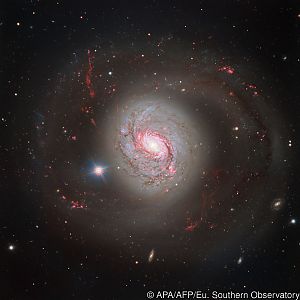Dust donut hides supermassive black hole

This is shown by observations with the "Very Large Telescope Interferometer" (VLTI) of the European Southern Observatory ESO. As an international team of researchers with Austrian participation reports in the scientific journal "Nature", the sharpest images of this constellation so far confirm a decades-old theory about "active galactic nuclei".
"Active Galactic Nuclei (AGN) are among the most luminous objects in the universe. They are extremely powerful sources of energy, powered by a supermassive black hole at the centre of certain galaxies. The fuel for the omnipresent AGN is large quantities of cosmic dust and gas that spiral towards the black hole, releasing enormous amounts of energy in the process.
Differently bright glow
Different appearances have been observed in AGNs that have been known for decades: Some "active galactic nuclei" shine brightly in visible light, others - like the nucleus of "Messier 77" observed in the current study - glow more dimly. According to the standard theory for AGN established 30 years ago, all "active galactic nuclei" have the same basic structure despite their differences: a supermassive black hole surrounded by a thick ring of dust and gas.
According to the standard model, the different appearance of the "active galactic nuclei" is due to the angle from which the black hole and its dust ring are viewed from Earth. There were already some observations that supported this theory, but doubts remained as to whether the dust ring could completely hide a black hole and thus make this AGN shine less brightly in visible light.
MATISSE brought the solution
The research team led by Violeta Gamez Rosas of Leiden University (Netherlands) has now observed the centre of the galaxy "Messier 77" (also known as NGC 1068), 47 million light years away, in the infrared range using the MATISSE instrument (Multi AperTure mid-Infrared SpectroScopic Experiment) at the VLTI in the Chilean Atacama Desert. The instrument uses interferometry to combine the infrared light collected by all four of the VLT's telescopes.
"This was not technologically possible until MATISSE was developed - even more so in the very large wavelength range of three to twelve micrometres," Josef Hron from the Institute of Astrophysics at the University of Vienna told APA. The possibility of connecting the four 8.2-metre telescopes together gave the scientists the resolution they needed to see what was going on inside even a galaxy as distant as "Messier 77".
Black hole precisely located
Combined with data from other telescopes, the team was able to create a detailed image of the dust and its various temperatures - from room temperature to 1,200 degrees Celsius - and determine exactly where the black hole must be located. They consider the results to be a confirmation of the standard model for "active galactic nuclei". And Robert Antonucci from the University of California in Santa Barbara (USA) also says in an accompanying commentary in "Nature" that the study is "the best proof yet that the Standard Model is correct".
MATISSE was developed over twelve years by scientists from France, Germany, the Netherlands, Austria and ESO, and saw "first light" in 2018. The University of Vienna financed parts of the cooled optics and the Viennese researchers are involved in the calibration of the instrument.
For Gamez Rosas, the work is "an important step towards understanding how AGN works". The results could also help to better understand the history of the Milky Way, which hosts a supermassive black hole at its centre that must have been active in the past," the researcher is quoted as saying in a release from the Max Planck Institute for Radio Astronomy in Bonn.
